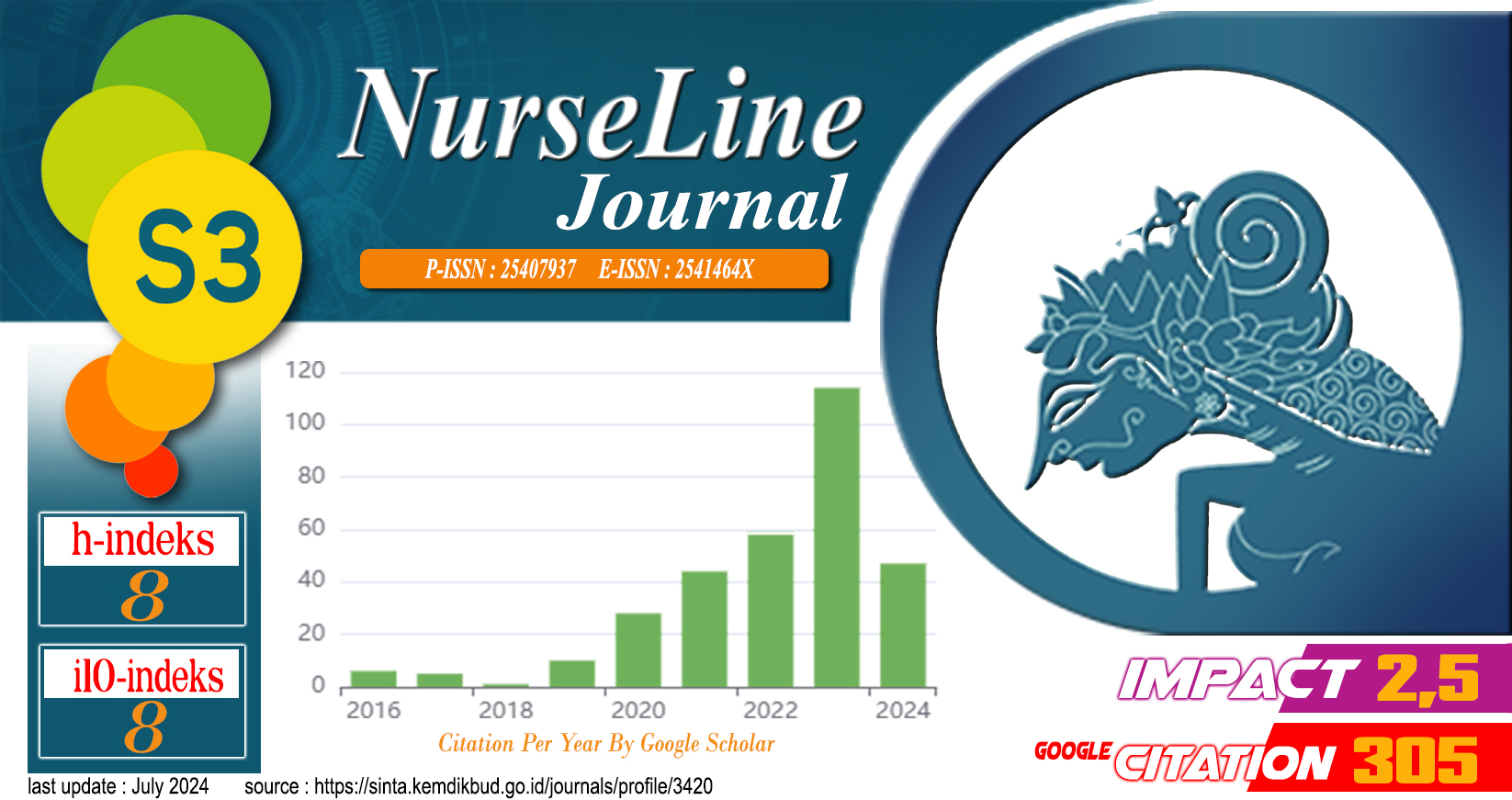Stigma of People Living with HIV/AIDS
Abstract
People living with HIV have many complex problems in their lives. Internal problems concern bio-psycho-socio-spiritual, while external problems concern the views and attitudes of others towards themselves. Negative views from other people formed long ago will give a bad stigma to people with HIV. The stigma of society has a great influence, not only affecting citizens but also health workers. This study aims to review the results of research related to stigma inherent in the community, especially nurses to people with HIV. The researcher sought the results of other studies through several databases including ProQuest, Scopus, Science Direct, PubMed, Medline, Springer link and Elsevier. Keywords to search literature include "stigma", "nurse" and "people with HIV". The results obtained were as many as 14 journals. Many studies have been carried out for prevention, treatment, and support for people with HIV / AIDS. But along with advances in the field of health need to continue to do problems related to people with HIV / AIDS.
References
Charles, B. et al. (2012) ‘Association between stigma, depression and quality of life of people living with HIV/AIDS (PLHA) in South India - A community based cross sectional study’, BMC Public Health. BMC Public Health, 12(1), p. 1. doi: 10.1186/1471-2458-12-463.
Cuca, Y. P. et al. (2017) ‘HIV Stigma and Social Capital in Women Living With HIV’, Journal of the Association of Nurses in AIDS Care. Elsevier Inc, 28(1), pp. 45–54. doi: 10.1016/j.jana.2016.09.001.
Demirel, O. F. et al. (2018) ‘Self-stigma, depression, and anxiety levels of people living with HIV in Turkey’, European Journal of Psychiatry, (xx). doi: 10.1016/j.ejpsy.2018.03.002.
DinasKesehatanTulungagung, K. P. A. (2018) ‘Kebijakan dan Ansit P2 HIV-AIDS Kabupaten Tulungagung’.
Direktorat Jenderal Pencegahan dan Pengendalian Penyakit (2017) ‘Laporan Perkembangan HIV/AIDS 7 Penyakit Menular Seksual (PIMS) Triwulan I Tahun 2017’, Faktor-Faktor Risiko Penularan HIV/AIDS pada Laki-Laki dengan Orientasi Seks HeteroseDirektorat Jenderal Pencegahan dan Pengendalian Penyakit (2017) ‘Laporan Perkembangan HIV/AIDS 7 Penyakit Menular Seksual (PIMS) Triwulan I Tahun 2017’, Faktor-Faktor Ris, pp. 1–402.
Harapan, H. et al. (2015) ‘ScienceDirect HIV-related stigmatized attitudes among health care providers in Aceh , Indonesia : The findings from a very low HIV case-load region §’, pp. 1–8. doi: 10.1016/j.poamed.2015.05.003.
Hill, M., Huff, A. and Chumbler, N. (2017) ‘Variation in Networks and Forms of Support for Care-Seeking Across the HIV Care Continuum in the Rural Southeastern United States’, 0, pp. 1–9. doi: 10.1111/jrh.12238.
Ismawati, I., Ikhtiar, M. and k Alwi, M. (2018) ‘Upaya Pencegahan Hiv Aids Berbasis Masyarakat Dengan Konsep Community System Strengthening Di Wilayah Kerja Puskesmas Baula Kab. Kolaka Tahun 2018.’, Patria Artha Journal of Nursing Science, 2(1), pp. 11–15.
Kamitani, E., Chen, J., et al. (2018) ‘Shortened and culturally appropriate HIV stigma scale for Asians living with HIV in the United States: Psychometric analysis’, Journal of the Association of Nurses in AIDS Care. Association of Nurses in AIDS Care. doi: 10.1016/j.jana.2018.02.007.
Kamitani, E., Chen, J. L., et al. (2018) ‘Shortened and Culturally Appropriate HIV Stigma Scale for Asians Living with HIV in the United States: Psychometric Analysis’, Journal of the Association of Nurses in AIDS Care. Elsevier Inc, pp. 1–10. doi: 10.1016/j.jana.2018.02.007.
Msn, R. V. and Dsn, S. D. (2008) ‘HIV / AIDS related stigma : Delivering appropriate nursing care’, 2003, pp. 59–66. doi: 10.1016/j.teln.2007.11.004.
Muhajir, Anton. (2016) 'Hidup Dalam Stigma, Ibu Rumah Tangga Pengidap HIV'. https://www.benarnews.org/indonesian/berita/ibu-rumah-tangga-aids-12082016151231.html
Nursalam, D. K. N. and Dian, N. (2007) ‘Asuhan keperawatan pada pasien terinfeksi HIV’, Jakarta: Salemba Medika.
Nursalam, N. and Efendi, F. (2008) ‘Pendidikan Dalam Keperawatan Education in Nursing’. Salemba Medika.
O’Brien, B. M. and L. T. (2005) ‘The Psychology of Stigma’.
O’Cofaigh, E. and Lewthwaite, P. (2013) ‘Natural history of HIV and AIDS’, Medicine. Elsevier Ltd, 41(8), pp. 411–416. doi: 10.1016/j.mpmed.2013.05.009.
Park, K.-O., Park, S.-H. and Yu, M. (2018) ‘Physicians’ Experience of Communication with
Paryati, T., Raksanagara, A. S. and Afriandi, I. (2012) ‘Faktor-faktor yang Mempengaruhi Stigma dan Diskriminasi kepada ODHA (Orang dengan HIV/AIDS) oleh petugas kesehatan: kajian literatur’, Abstrak.
Pereira, H., Caldeira, D. and Monteiro, S. (2017) ‘Perceptions of HIV-Related Stigma in Portugal Among MSM With HIV Infection and an Undetectable Viral Load’, Journal of the Association of Nurses in AIDS Care. Elsevier Inc, 29(3), pp. 439–453. doi: 10.1016/j.jana.2017.12.002.
Purwaningsih, Misutarno and Imamah, S. N. (2017) ‘Analisis Faktor Pemanfaatan Vct Pada Orang Risiko Tinggi HIV/AIDS’, Jurnal Ners, 6, pp. 58–67.
Rice, W. S. et al. (2018) ‘Perceptions of intersectional stigma among diverse women living with HIV in the United States’, Social Science & Medicine. Elsevier, 208(January), pp. 9–17. doi: 10.1016/j.socscimed.2018.05.001.
Servais, L. M. et al. (2007) ‘What is psychiatric stigma?’, The Journal of social psychology, 56(2), pp. 363–385. doi: 10.1146/annurev.psych.56.091103. 070137.
Spooner, C. et al. (2015) ‘Impacts of stigma on HIV risk for women who inject drugs in Java: A qualitative study’, International Journal of Drug Policy. Elsevier B.V., 26(12), pp. 1244–1250. doi: 10.1016/j.drugpo.2015.07.011.
Tintin Sukartini, Nursalam, Eka Mishbahatul M.Has, Candra Panji Asmoro, M. (2017) ‘Improving Psychological Response on Indonesian ’ s Migran t Worker ( TKI ) Infected by HIV Through Family and Peer Group Support’.
Villarinho, M. V and Padilha, M. I. (2016) ‘Feelings reported by health workers when facing the aids epidemic (1986–2006) ’, Texto e Contexto Enfermagem. Florianópolis, Santa Catarina, Brazil: Universidade Federal de Santa Catarina, 25(1). doi: 10.1590/0104-07072016000010013.
Waluyo, A. et al. (2015) ‘Understanding HIV-related Stigma Among Indonesian Nurses’, Journal of the Association of Nurses in AIDS Care. Elsevier Ltd, 26(1), pp. 69–80. doi: 10.1016/j.jana.2014.03.001.
Wirahayu, Y. Aa. And Satyabakti, P. (2014) ‘Pencegahan Hiv/Aids Pada Anggota Tni-Al Dilihat Dari Pengetahuan Sikap Dan Tindakan Prevention Of Hiv/Aids In Indonesian Navy Views Of Knowledge, Attitude, And Practice’, Berkala Epidemiologi, 2(2), Pp. 161–170.
Xiaowen, W. et al. (2018) ‘Depression and anxiety mediate perceived social support to predict health-related quality of life in pregnant women living with HIV’, AIDS Care. Taylor & Francis, 0(0), pp. 1–9. doi: 10.1080/09540121.2018.1456640.

This work is licensed under a Creative Commons Attribution-ShareAlike 4.0 International License.
















